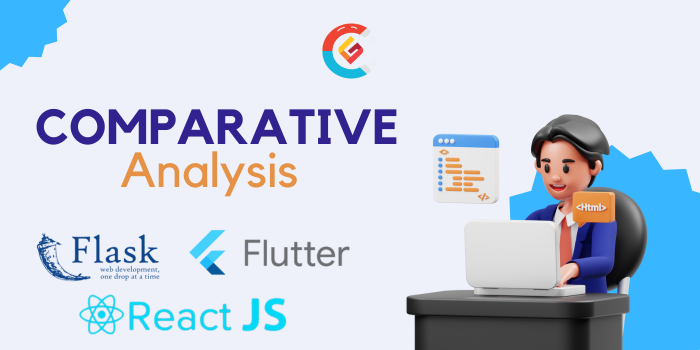
A Comparative Development Analysis of Flask, React JS, and Flutter
Exploring Frontend and Backend Technologies
In this technical analysis, we’ll assess Flask as the backend, React JS as the web frontend, and Flutter for the mobile frontend. In the course we will evaluate these methods and see their strengths and weaknesses and compare them according to the needs of the situation at hand.
Backend Technology: Flask
Advantages:
Lightweight and Minimalistic: Flask is a micro-framework, and thus, being lightweight and minimalistic, it enables developers to have flexibility and simplicity during the development process.
Easy to Learn and Use: Flask is simple and intuitive in its design and this makes learning the coding and start-up easy for developers.
Extensive Documentation: Flask has a well-documented system that includes guidance and help for developers in all the development stages.
Flexible and Extensible: Flask helps developers use extensions that are based on the project requirements so that they can integrate extra functions easily without much disruption.
Python Ecosystem: Having been built on Python, Flask utilizes the amazing Python ecosystem, with the ability to use so many different libraries and tools for almost every task.
Disadvantages:
Limited Functionality: The simplicity of Flask’s design may be a limitation of functionality when dealing with large and complex applications than full-stack frameworks such as Django.
Scalability Challenges: However, though Flask can handle small and medium-scale applications well enough, it may show some problems in scalability for large-scale projects without proper architecture design.
Lack of Built-in Features: In contrast to full-stack frameworks, Flask does not offer a wide range of built-in features like authentication, database ORM, and admin panels, therefore, developers need to use third-party extensions or develop custom solutions.
Frontend Technology: React JS
Advantages:
Declarative and Component-Based: React JS takes the declarative and component approach, which helps to create and support complex UI.
Virtual DOM: React’s virtual DOM enhances performance by reducing the need for frequent manipulation of the DOM, thus ensuring faster rendering and better user experience as well.
Large Ecosystem and Community: React has a large ecosystem of libraries, tools, and a community support system that supplies developers with solutions to a wide variety of development problems.
Reusable Components: React’s component-based architecture encourages code reusability which results at creating modular and scalable UI components.
SEO-Friendly: React can be used for server-side rendering, hence the resulting pre-rendered HTML is delivered to web crawlers, thus improving search engine optimization.
Disadvantages:
JSX Complexity: React may involve a steeper learning curve for programmers who are used to traditional HTML and JavaScript markup since it requires them to use JSX (JavaScript XML).
Toolchain Complexity: The introduction of tools such as Babel and Webpack to the React development environment makes the setting of the environment and the configuration more complex.
Rapidly Evolving Ecosystem:
React, and its ecosystem evolve quickly and this could cause compatibility issues and the need to always keep updated with the latest changes and the best practices.
Steep Learning Curve: The basics of React are relatively simple to understand but there are advanced concepts like state management with Redux or the Context API which requires time and effort.
Mobile Frontend Technology: Flutter
Advantages:
Single Codebase: Flutter provides a tool for developers to create cross-platform mobile apps using a single code base thus lowering the development time and effort.
Hot Reload: The code hot reloading feature of Flutter enables developers to see the results of their changes instantly, thereby accelerating the development process and productivity.
Rich UI and Customization: Features of Flutter include customizable widgets and design options, which enable developers to build visual and engaging user interfaces.
High Performance:
The compiled code of Flutter directly runs on the native platform and it gives high performance and smooth animations, which is almost similar to the performance of the native apps.
Strong Community Support: Flutter is gaining a lot of traction among the developer community, offering them the support, resources, and third party packages they require for their specific development needs.
Disadvantages:
Immature Ecosystem: As opposed to the more established frameworks such as React Native, Flutter’s ecosystem is still quite young, and there are fewer libraries, tools, and resources so far.
Platform-Specific Code: Though being cross-platform, Flutter may need platform-specific code for a few features/ functionalities that are not supported by Flutter framework.
Large App Size: Flutter applications have bigger file sizes than native applications because Flutter engine is present in the applications and this might affect download and installation times.
Limited Native Integrations: While Flutter offers plugins for using platform specific features, it may not provide all the native integrations that are available in the native development platforms.
Comparison and Conclusion:
Flask, React JS, and Flutter have their pros and cons, which make them unique in building web and mobile applications. Flask gives simplicity and flexibility in the backend development, React JS however does best in building dynamic and interactive websites. While Flutter is the opposite of this, it allows developers to build mobile apps that perform well and give users experiences that are similar to native ones.
In this case, as per the requirements, the selection of the technology stack relies on factors like project complexity, development time frame, scalability and the team’s skill set. Flask could work for lightweight backend services, React JS for complex web apps and Flutter for cross-platform mobile apps that prioritize performance and user experience. Visit our site for web and mobile development services and courses. Use our web toolkit to enhance your online experience.
Is Flask suitable for building large and complex web applications?
While Flask is lightweight and offers simplicity, it may face limitations in handling large and complex applications compared to full-stack frameworks like Django.
Does Flask provide built-in features like authentication and database ORM?
No, Flask does not offer a wide range of built-in features. Developers may need to rely on third-party extensions or develop custom solutions for features like authentication and database ORM.
Is React JS SEO-friendly?
Yes, React JS can be used for server-side rendering, improving search engine optimization by delivering pre-rendered HTML to web crawlers.
What are the challenges of using React JS?
React JS may involve JSX complexity and toolchain complexity with the introduction of tools like Babel and Webpack, which can make environment setup and configuration more complex.
Can Flutter be used to build cross-platform mobile apps with a single codebase?
Yes, Flutter allows developers to create cross-platform mobile apps using a single codebase, reducing development time and effort.
Does Flutter offer hot reload for instant results during development?
Yes, Flutter provides a hot reload feature that allows developers to see the results of their changes instantly, accelerating the development process.




